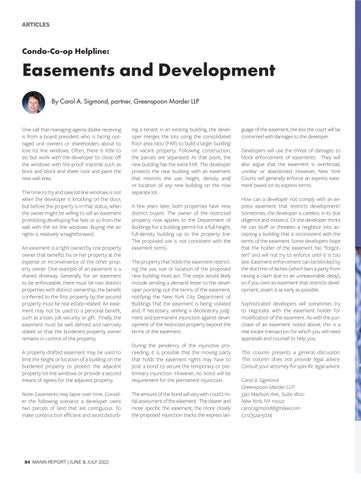ARTICLES
Condo-Co-op Helpline:
Easements and Development By Carol A. Sigmond, partner, Greenspoon Marder LLP
One call that managing agents dislike receiving is from a board president who is facing outraged unit owners or shareholders about to lose lot line windows. Often, there is little to do but work with the developer to close off the windows with fire-proof material such as brick and block and sheet rock and paint the new wall area. The time to try and save lot line windows is not when the developer is knocking on the door, but before the property is in that status, when the owner might be willing to sell an easement prohibiting developing five feet or so from the wall with the lot line windows. Buying the air rights is relatively straightforward. An easement is a right owned by one property owner that benefits his or her property at the expense or inconvenience of the other property owner. One example of an easement is a shared driveway. Generally, for an easement to be enforceable, there must be two distinct properties with distinct ownership; the benefit conferred to the first property by the second property must be real estate-related. An easement may not be used to a personal benefit, such as a loan, job security or gift. Finally, the easement must be well defined and narrowly stated so that the burdened property owner remains in control of the property.
ing a tenant in an existing building, the developer merges the lots using the consolidated floor area ratio (FAR) to build a larger building on vacant property. Following construction, the parcels are separated. At that point, the new building has the extra FAR. The developer protects the new building with an easement that restricts the use, height, density and/ or location of any new building on the now separate lot. A few years later, both properties have new, distinct buyers. The owner of the restricted property now applies to the Department of Buildings for a building permit for a full-height, full-density building up to the property line. The proposed use is not consistent with the easement terms. The property that holds the easement restricting the use, size or location of the proposed new building must act. The steps would likely include sending a demand letter to the developer pointing out the terms of the easement, notifying the New York City Department of Buildings that the easement is being violated and, if necessary, seeking a declaratory judgment and permanent injunction against development of the restricted property beyond the terms of the easement.
A properly drafted easement may be used to limit the height or location of a building on the burdened property to protect the adjacent property lot line windows or provide a second means of egress for the adjacent property.
During the pendency of the injunctive proceeding, it is possible that the moving party that holds the easement rights may have to post a bond to secure the temporary or preliminary injunction. However, no bond will be requirement for the permanent injunction.
Note: Easements may lapse over time. Consider the following scenario: a developer owns two parcels of land that are contiguous. To make construction efficient and avoid disturb-
The amount of the bond will vary with court’s initial assessment of the easement. The clearer and more specific the easement, the more closely the proposed injunction tracks the express lan-
84 MANN REPORT | JUNE & JULY 2022
guage of the easement, the less the court will be concerned with damages to the developer. Developers will use the threat of damages to block enforcement of easements. They will also argue that the easement is overbroad, unclear or abandoned. However, New York Courts will generally enforce an express easement based on its express terms. How can a developer not comply with an express easement that restricts development? Sometimes, the developer is careless in its due diligence and misses it. Or the developer thinks he can bluff or threaten a neighbor into accepting a building that is inconsistent with the terms of the easement. Some developers hope that the holder of the easement has “forgotten” and will not try to enforce until it is too late. Easement enforcement can be blocked by the doctrine of laches (which bars a party from raising a claim due to an unreasonable delay), so if you own an easement that restricts development, assert it as early as possible. Sophisticated developers will sometimes try to negotiate with the easement holder for modification of the easement. As with the purchase of an easement noted above, this is a real estate transaction for which you will need appraisals and counsel to help you. This column presents a general discussion. This column does not provide legal advice. Consult your attorney for specific legal advice. Carol A. Sigmond Greenspoon Marder LLP 590 Madison Ave., Suite 1800 New York, NY 10022 carol.sigmond@gmlaw.com (212)524-5074

























